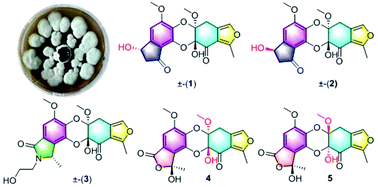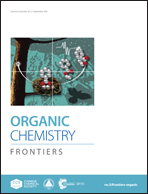Canescones A–E: aromatic polyketide dimers with PTP1B inhibitory activity from Penicillium canescens†
Abstract
Three pairs of enantiomers (±)-canescones A–C (1–3), along with a pair of stereoisomers canescones D (4) and E (5), aromatic polyketide dimers bearing unprecedented 5/6/6/6/5 heterocyclic chemical architectures with a rare pentacyclic dihydrobenzo[1,4]dioxine core, were isolated from the fungus Penicillium canescens. Structure elucidation unambiguously suggests that 1 and 2 feature a new cyclopentanone ring A rather than a pyrrolidinone or furanone ring present in 3–5. All compounds were assayed for PTP1B inhibitory activity, and their hypothetical biosynthetic pathways were proposed.



 Please wait while we load your content...
Please wait while we load your content...